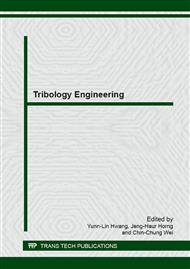p.202
p.207
p.212
p.217
p.222
p.227
p.231
p.236
p.242
Analysis of Sliding Friction for Surface with Micro-Scale Circumferential Grooves
Abstract:
Friction is a crucial issue for the performance of a machine with sliding mechanism. While the sliding surface is often manually scraped to improve its tribological properties, the quality is not stable nor the efficiency of the scraping process. This study investigated the influences of micro-scale circumferential grooves on the frictional characteristics of a sliding surface through theoretical analysis and numeric simulations. The study found that sliding surface with micro grooves can reduce the friction, compared to plain surface. An in-depth analysis indicated that the slider with micro-scale grooves was uplifted when it slides, thus reduced the sliding friction. Moreover, as the amount of lubricant collected on the grooves increased, the friction force decreased with time and approached a stable condition.
Info:
Periodical:
Pages:
222-226
Citation:
Online since:
April 2015
Authors:
Price:
Сopyright:
© 2015 Trans Tech Publications Ltd. All Rights Reserved
Share:
Citation:


